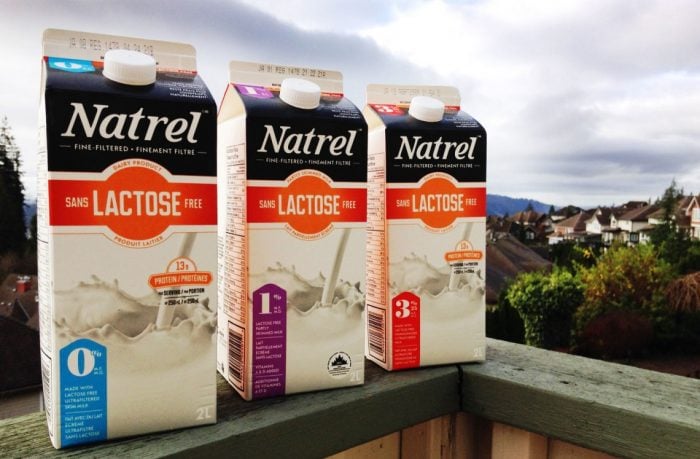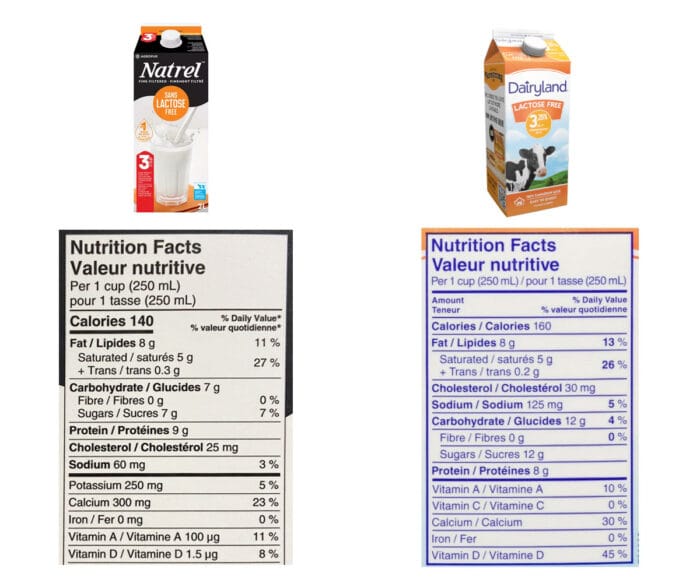
Written By: Gloria Tsang, RD
Title: Founding Registered Dietitian
Alumni: University of British Columbia
Last Updated on:


There is a very good chance that you or someone that you know is lactose intolerant. More than 7 million Canadians do indeed live with this condition every day. What is lactose intolerance? In short, when your body is unable to produce enough of the lactase enzyme, any milk sugar (lactose) that you eat will be passed into your gut undigested. Bacteria in your intestine then ferments the lactose and produces enough gas to cause you discomfort. Symptoms usually include bloating, flatulence and diarrhea.
Table of Contents
Before we get to an easy way to determine if you are indeed lactose intolerant, let’s be clear and differentiate between lactose intolerant and an allergy to milk; they are completely different issues. Milk allergic means your body is allergic to the milk protein (casein) and actually develops an allergic reaction. Whereas lactose intolerance is just that, your body is not able to tolerate lactose (hence it’s an “intolerance”). Both cases, however, share some similar symptoms, like cramping and diarrhea.
The best way to determine if you are lactose intolerant is to completely remove lactose from dairy in your diet for 1-2 weeks. If symptoms go away after a week or two of not eating any lactose products, there is a good chance that you are indeed lactose intolerant.
The most distinct comment from users who drink lactose free milk is that it tastes sweeter. This make sense chemically; bare with me for a moment while my inner nutrition geek takes over. Lactose is a disaccharide (sugar made up of 2 molecules so to speak; glucose and galactose). In lactose free milk, the manufacturer has used the lactase enzyme to break lactose down into their monosaccharide constituents. Both glucose and galactose taste sweeter on your tongue than lactose; this is exactly why lactose free milk usually tastes sweeter than regular milk.
A typical lactose-free milk ingredient list has milk and the lactase enzyme. Here’s an ingredient list of Natrel Lactose-Free Milk:

Ingredients: Ultrafiltered milk with vitamin D3 added, water, lactase.
Having a sweeter tasting milk may be a turnoff for some people and when specific recipes call for milk to be added, it may not be appropriate to add a sweet ingredient. So what options are out there?
Natrel reached out to us at HealthCastle.com and asked us to put their lactose free milk to the taste test. So took up the challenge and brought these Natrel products into our test kitchen – 0% skim milk, 1% and 3.25 % homogenized.
At the time of our taste testing, the local grocery store was sold out of the 2% version, that’s how popular it was.
For our taste testing panel, we sampled:
Our tasting session was not meant as a test to see if panelists could identify brands or milk fat content. We simply tried all samples a few times to see how they were different.
Testers immediately reported that Dairyland and Lactantia lactose free milk tasted very similar to each other and had a sweeter taste than regular milk. Interestingly, our taste testers also unanimously agreed that all Natrel milk did not have the familiar sweet taste normally associated with lactose free milk.
Given that our panelists were made up of dietitians, we were all curious to find out how Natrel does not taste as sweet. A quick glance at the Natrel nutrition labels show that there is indeed less sugar in each serving of their lactose free milk as compared to other brands (lactose free or not). Typically, most milk products contain 12 grams of sugar per serving. We were surprised to find that the Natrel 0% and 1% products contained only 8 grams of sugar and the 3.25% version contained 7 grams. This is probably the main reason that the Natrel products did not taste as sweet as other lactose free milk.
After trying the various samples a few times, our tasters could tell the difference between Natrel lactose free 3.25% and the regular lactose-containing Dairyland Organic 3.25% milk. However, the difference we detected was not obvious and it took some time to really figure out if there was indeed a slight difference. As a group, we decided that the difference was not significant and that if a typical consumer did not try both products side-by-side, it would be difficult to tell any difference at all.
When comparing the Natrel lactose free 3.25% to the regular lactose-containing whole milk, in addition to less sugar (and hence less net carb), we noticed that the Natrel product also contained more protein per serving! This is good news for anyone looking to add more protein into your diet.

| (per cup) | Natrel 3.25% Lactose Free Milk | Dairyland 3.25% Lactose Free Milk |
| Calories | 140 | 160 |
| Fat | 8 g | 8 g |
| Saturated Fat | 5 g | 5 g |
| Trans Fat | 0.2 g | 0.2 g |
| Carbohydrate | 7 g | 12 g |
| Fibre | 0 g | 0 g |
| Sugars | 7 g | 12 g |
| Protein | 9 g | 8 g |
There you have it. The results are in and it is clear that Natrel has come up with a unique line of lactose free milk that can safely be substituted for regular milk, as well as in recipes calling for regular milk.
Alumni: University of British Columbia – Gloria Tsang is the author of 6 books and the founder of HealthCastle.com, the largest online nutrition network run by registered dietitians. Her work has appeared in major national publications, and she is a regularly featured nutrition expert for media outlets across the country. The Huffington Post named her one of its Top 20 Nutrition Experts on Twitter. Gloria’s articles have appeared on various media such as Reuters, NBC & ABC affiliates, The Chicago Sun-Times, Reader’s Digest Canada, iVillage and USA Today.
lactose free milk, lactose intolerance, milk, natrel, protein
I am lactose intolerant and found this article very interesting. I ordinarily buy Natrel milk anyway. I wonder if lactose free products are different in amount or efficiency of the lactaze enzyme. This factor is not listed as a quantitative ingredient. Specifically, does lactose free milk in the USA differ from Canadian products with respect to how “lactose free” it is? I am amazed at the relative lack and poor quality of lactose free products after being in the US for a few months.
Thanks very much for exploring this issue.
I have Type 1 Diabetes. Natrel has fewer carbs than Lactantia, like 7 versus 13! This matters a lot!